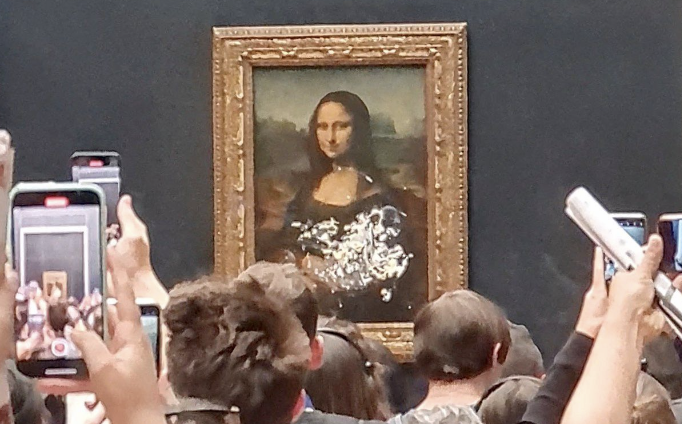
‘A visitor to the Louvre tried to smash the glass protecting the world’s most famous painting before smearing cream across its surface’- the news outlet Reuters reported in May 2022. Seeing these outlandish headlines some months ago definitely brought global attention to the fight against climate change once again. The attempted destruction of world-renowned works of art was one of the many extreme actions taken by environmental organizations in recent months to bring media attention to the crisis our planet is facing. Such events caught the world’s attention, flooding social media with photos of activists throwing food at paintings or gluing themselves to highways, but is this attention really beneficial for the cause or does it trivialize the serious issues that these organizations are trying to bring to light?
The media coverage that these events received was certainly unflattering, and while it is known that the art was not truly destroyed (or even harmed) this is not necessarily clear in the way that it was reported. Attention-grabbing headlines such as ‘Climate Activists Throw Mashed Potatoes on Monet Painting’ (New York Times) and images of other seemingly destroyed pieces flooded social media. It was not obvious from the get-go that the paintings were protected by glass frames and remained unharmed, insighting outrage amongst the public. Although the manipulation of the events, excluding these details, can be criticized as clickbait, it is also inevitable in modern media. By using such controversial tactics the protesters allow themselves to fall victim to negative representation in the media. A high proportion of viewers will feel annoyed when seeing these articles on the news, as the artworks in question are highly valued by our society due to their historical and cultural significance. Their destruction appears to be bizarre and pointless. There is also a lack of obvious correlation between the protesters’ message and their actions, as Michael E. Mann (a distinguished professor of atmospheric science and director of the Earth System Science Center at Penn State University) observes. Throwing food and paint at artworks, cherished by our society, feels more like an act of vandalism than a protest with a powerful message.
The protesters dispute all criticism, arguing that the message they are communicating is more important than the potential destruction they could cause. “We are in a climate catastrophe and all you are afraid of is tomato soup or mashed potatoes on a painting,” – one of the protesters said. While this may seem like an obvious statement, it does not truly reflect the impact of their actions. This reasoning does not take into account that people may not immediately see the important message the protesters are trying to spread, but rather a simple destruction of something they see as valuable. Seeing this, we are not predisposed to agree with the destructor, in fact, we are less likely to support the cause as a whole if it is introduced to us in this manner. In fact, in a survey by Annenberg Policy Center for Time.com, it is shown that for 46% of respondents, nonviolent disruptive actions actually decrease their support for efforts to address climate change, and for another 40% they have no effect. This means that such actions would create a positive effect on the environmentalist movement only for a small minority of the people surveyed. Hence, these disruptive actions are completely counterintuitive publicity tactics. The actions can often be perceived as radical and unreasonable by many, by association making the environmental movement seem extremist and unappealing. By creating controversy associated with being an activist these organizations make it even harder for most members of society to feel inclined to support them. Unity and collective effort are crucial in our fight against climate change, but extreme environmentalism divides society rather than brings it together.
Environmentalist protests have been going on for many years and these recent developments may be worrying to some, and may even be destructive to the movement as a whole. In the end, we are left wondering how such a negative media representation will affect our ability as a society to address the importance and urgency of the issue we are facing, and hoping for better, peaceful steps to be taken in the future.